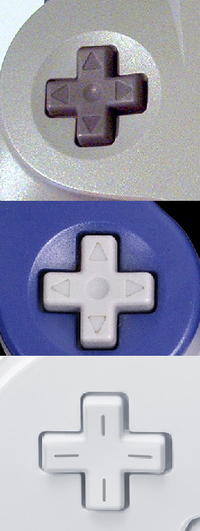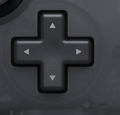Directional pad: Difference between revisions
mNo edit summary |
No edit summary Tag: Disambiguation links |
||
| Line 5: | Line 5: | ||
The '''directional pad''' (shortened '''d-pad''', officially '''+Control Pad''') refers to the grey, cross-shaped group of buttons on the left side of the [[GameCube controller|GameCube]] and [[Nintendo 64 controller|Nintendo 64]] [[controller]]s, the cross-shaped group of buttons located on the [[Wii Remote]], [[Classic Controller]], [[Nintendo 3DS]], [[Wii U GamePad]], and [[Wii U Pro Controller]], and grey, cross-shaped group of buttons on the left side of the [[Nintendo Switch Pro Controller]]. The left [[Joy-Con]] has a group of four buttons in a diamond shape in the same place called the directional buttons, with the same purpose. The colour of the D-Pad on the Nintendo 3DS varies, but it matches the colour of the Wii Remote, Wii Classic Controller, Wii U GamePad and Wii U Pro Controller. | The '''directional pad''' (shortened '''d-pad''', officially '''+Control Pad''') refers to the grey, cross-shaped group of buttons on the left side of the [[GameCube controller|GameCube]] and [[Nintendo 64 controller|Nintendo 64]] [[controller]]s, the cross-shaped group of buttons located on the [[Wii Remote]], [[Classic Controller]], [[Nintendo 3DS]], [[Wii U GamePad]], and [[Wii U Pro Controller]], and grey, cross-shaped group of buttons on the left side of the [[Nintendo Switch Pro Controller]]. The left [[Joy-Con]] has a group of four buttons in a diamond shape in the same place called the directional buttons, with the same purpose. The colour of the D-Pad on the Nintendo 3DS varies, but it matches the colour of the Wii Remote, Wii Classic Controller, Wii U GamePad and Wii U Pro Controller. | ||
==Overview== | |||
While the directional pad has appeared in some form across every console the ''Smash'' series has been playable on, its functionality has varied over the years. In ''[[Super Smash Bros.]]'', it serves no purpose other than menu navigation. When played on the [[Wii]] using a GameCube controller or Classic Controller, the d-pad is analogous to the N64 controller's [[L button]], used for the character's [[taunt]]. | |||
In ''[[Super Smash Bros. Melee]]'', it continues to function as menu navigation, but also has a number of other uses. Pressing up during a fight will make the player's character [[taunt]]. The d-pad is also used for activating Fox and Falco's [[Smash Taunt|secret taunts]] and [[Samus's Extended Grapple]]. In [[Camera Mode]] and the Trophy Gallery, the d-pad can be used to move the camera. In ''Melee'', the directional pad also has uses not intended in regular gameplay: through the {{SSBM|debug mode}}, it can be used to toggle the game mode, control {{SSBM|Master Hand}} (also possible with the [[Name Entry glitch]]) and/or {{SSBM|Crazy Hand}}, and spawn items in-game, among other things.<ref>http://tcrf.net/Super_Smash_Bros._Melee/Master_Debug_Menu</ref> | |||
In '' | In ''[[Super Smash Bros. Brawl]]'', it takes the role of the [[control stick]] when played on a Wiimote, and reprises its role of taunts for any other controller. When using the Wii Remote with the [[Nunchuk]], pressing up will make the character [[jump]], while pressing sideways will make the character [[grab]] in specified direction, and pressing down will let the character [[shield]]. The [[controls]] menu option introduced in this game allows non-default actions to be mapped to the d-pad. | ||
In ''Ultimate'', | In {{for3ds}}, it once again takes the role of being used for the character's taunt, whereas in {{forwiiu}}, any controller reprises its role for taunts. Different actions can once again be mapped to the d-pad. | ||
In ''Ultimate'', the Joy-Cons do not have a d-pad built in. When using both Joy-Cons at once, the four buttons on the left that mirror the [[A]], [[B]], [[X]], and [[Y]] buttons on the right substitute for a d-pad. When using a single Joy-Con held horizontally, what would be d-pad buttons are instead set to different actions, as the right button acts like an A button and is used for performing standard attacks, while the bottom button acts like a B button and is used for performing special attacks, and the top and left buttons act like X and Y buttons and are used for jumping. All other compatible controllers have a traditional d-pad and it functions like in previous games with the ability to be mapped to different actions. | |||
==Gallery== | ==Gallery== | ||
Revision as of 16:28, March 29, 2023
The directional pad (shortened d-pad, officially +Control Pad) refers to the grey, cross-shaped group of buttons on the left side of the GameCube and Nintendo 64 controllers, the cross-shaped group of buttons located on the Wii Remote, Classic Controller, Nintendo 3DS, Wii U GamePad, and Wii U Pro Controller, and grey, cross-shaped group of buttons on the left side of the Nintendo Switch Pro Controller. The left Joy-Con has a group of four buttons in a diamond shape in the same place called the directional buttons, with the same purpose. The colour of the D-Pad on the Nintendo 3DS varies, but it matches the colour of the Wii Remote, Wii Classic Controller, Wii U GamePad and Wii U Pro Controller.
Overview
While the directional pad has appeared in some form across every console the Smash series has been playable on, its functionality has varied over the years. In Super Smash Bros., it serves no purpose other than menu navigation. When played on the Wii using a GameCube controller or Classic Controller, the d-pad is analogous to the N64 controller's L button, used for the character's taunt.
In Super Smash Bros. Melee, it continues to function as menu navigation, but also has a number of other uses. Pressing up during a fight will make the player's character taunt. The d-pad is also used for activating Fox and Falco's secret taunts and Samus's Extended Grapple. In Camera Mode and the Trophy Gallery, the d-pad can be used to move the camera. In Melee, the directional pad also has uses not intended in regular gameplay: through the debug mode, it can be used to toggle the game mode, control Master Hand (also possible with the Name Entry glitch) and/or Crazy Hand, and spawn items in-game, among other things.[1]
In Super Smash Bros. Brawl, it takes the role of the control stick when played on a Wiimote, and reprises its role of taunts for any other controller. When using the Wii Remote with the Nunchuk, pressing up will make the character jump, while pressing sideways will make the character grab in specified direction, and pressing down will let the character shield. The controls menu option introduced in this game allows non-default actions to be mapped to the d-pad.
In Super Smash Bros. for Nintendo 3DS, it once again takes the role of being used for the character's taunt, whereas in Super Smash Bros. for Wii U, any controller reprises its role for taunts. Different actions can once again be mapped to the d-pad.
In Ultimate, the Joy-Cons do not have a d-pad built in. When using both Joy-Cons at once, the four buttons on the left that mirror the A, B, X, and Y buttons on the right substitute for a d-pad. When using a single Joy-Con held horizontally, what would be d-pad buttons are instead set to different actions, as the right button acts like an A button and is used for performing standard attacks, while the bottom button acts like a B button and is used for performing special attacks, and the top and left buttons act like X and Y buttons and are used for jumping. All other compatible controllers have a traditional d-pad and it functions like in previous games with the ability to be mapped to different actions.
Gallery
References
| Controllers and buttons | |
|---|---|
| Nintendo 64 controller | |
| GameCube controller | |
| Wii Remote (and Nunchuk) | |
| Classic Controller | L |
| Nintendo 3DS | |
| Wii U GamePad / Pro Controller | L |
| Joy-Con | |
| Switch Pro Controller | L |
| Third-party controllers | Hori Mini Pad · Arcade controller · Keyboard |
| Other | Smash Controller · Controller modification |

